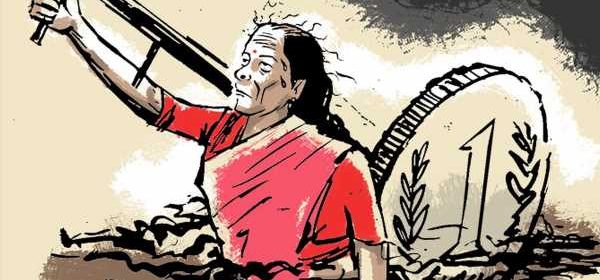Budget: Despite talk of cutback, central schemes’ outlay on rise

The number of centrally sponsored schemes have increased to 35 in FY22 from 30 in FY21 and central sector schemes have increased to 704 from 685 in the previous year, reports Dilasha Seth.
While Finance Minister Nirmala Sitharaman suggested rationalisation of centrally sponsored schemes and central sector schemes, the outlay to these have in fact seen a sharp growth in 2021-22.
The number of centrally sponsored schemes has increased to 35 in FY22 from 30 in FY21 and central sector schemes has increased to 704 from 685 in the previous year.
The new CSSs include Mission Shakti, Saksham Anganwadi, Poshan 2.0, and Rashtriya Pashudhan Vikash Yojana.
“On the recommendation of the Fifteenth Finance Commission, we have undertaken a detailed exercise to rationalise and bring down the number of centrally sponsored schemes. This will enable consolidation of outlays for better impact,” Sitharaman said in her Budget speech.
She announced a big-ticket new centrally sponsored scheme, PM Atmanirbhar Swasth Bharat Yojana, an outlay of about Rs 64,180 crore over six years.
“This will develop capacities of primary, secondary, and tertiary care health systems, strengthen existing national institutions, and create new institutions, to cater to detection and cure of new and emerging diseases. This will be in addition to the National Health Mission,” the FM announced.
Allocation to centrally sponsored schemes went up by 12.8 per cent in 2021-22 if compared with the Budget Estimate of 2020-21 (normal year assumption), which had seen growth of 9.8 per cent in the outlay.
The allocation is, however, 1.7 per cent lower compared to the revised estimates of FY21, as the government had to increase spending to rescue the economy from the impact of the pandemic.
Share of CSS marginally reduced to 10.94 per cent in FY22, compared to 11.1 per cent in FY21 budget estimates and 11.2 per cent in FY22.
While the Union government fully funds the central sector schemes, centrally sponsored schemes are jointly funded by the Centre and states.
There are six core of the core schemes that are the most important for the central government, including National Social Assistance Programme, and the Mahatma Gandhi National Rural Employment Guarantee Programme.
Similarly, central sector schemes have seen a massive jump in allocation of 26.4 per cent compared to the Budget Estimates of FY21, which had seen a 9.8 per cent increase in allocation. However, compared to revised estimates of FY21, it is 16.7 per cent lower.
Share of central sector schemes has increased to 30.1 per cent in the total expenditure in FY22, compared to 27.3 per cent allocated in the budget last year and 36.6 per cent in revised estimates of FY21.
“If one looks at the expenditure profile and see the Budget allocation for centrally sponsored schemes, it seems that rationalisation is a work in progress. It makes sense from operational point of view that all programmes targeted at common focus area operating under different ministries or department to be consolidated into one scheme,” said Devendra Kumar Pant, chief economist, India Ratings.
The Fifteenth Finance Commission in its report recommended that centrally sponsored schemes should be flexible enough to allow states to adapt and innovate.
“Top-down mandates and strictures on programme implementation are the antithesis of an open-source model,” it said.
The report tabled on Monday also suggested that the CSS should grant states significant latitude to tailor implementation modalities to local realities.
“The new PMJAY (Ayushman Bharat) programme allows states to co-brand with their own schemes, to choose whether to adopt a trust or insurance mode, to use the Government of India IT system or their own, to adapt the benefit package and eligibility/coverage groups, and so on,” it said.
The report said that the Centre can shift the focus of CSS and transfers away from line-items and activities and towards outputs and outcomes, with states being empowered to choose their own pathways to achieve results.
“Financing can be provided based on bilaterally agreed ‘compacts’ related to specific objectives (for example, service delivery outputs or specific outcomes) instead of exhaustively discussed implementation plans,” it said.
The report pointed out that the schematic transfers of the Centre in the form of CSS and CS to the states and Union Territories amounted to 12.81 per cent of the gross revenue receipts of the Union Government during the award period 2015-16 to 2019-20.
“For 2021-22 to 2025- 26, we have pegged the schematic transfers to the states to an average of 12.82 per cent of the gross revenue receipts of the Union government, similar to the 14th Finance Commission period,” it said.
In the 2015-16 Budget, the Centre had delinked eight CSSs, including the National e-Governance Plan, Backward Regions Grant Funds, Modernisation of Police Forces, and Rajiv Gandhi Panchayat Sashaktikaran Abhiyaan, from its support.
The sharing pattern was changed for 24 CSSs with sates having to contribute a higher share, while 31 continued to get full central sponsorship.
The change was made in view of the higher devolution to states from 32 per cent to 42 per cent.
- Union Budget 2021-22
Source: Read Full Article
